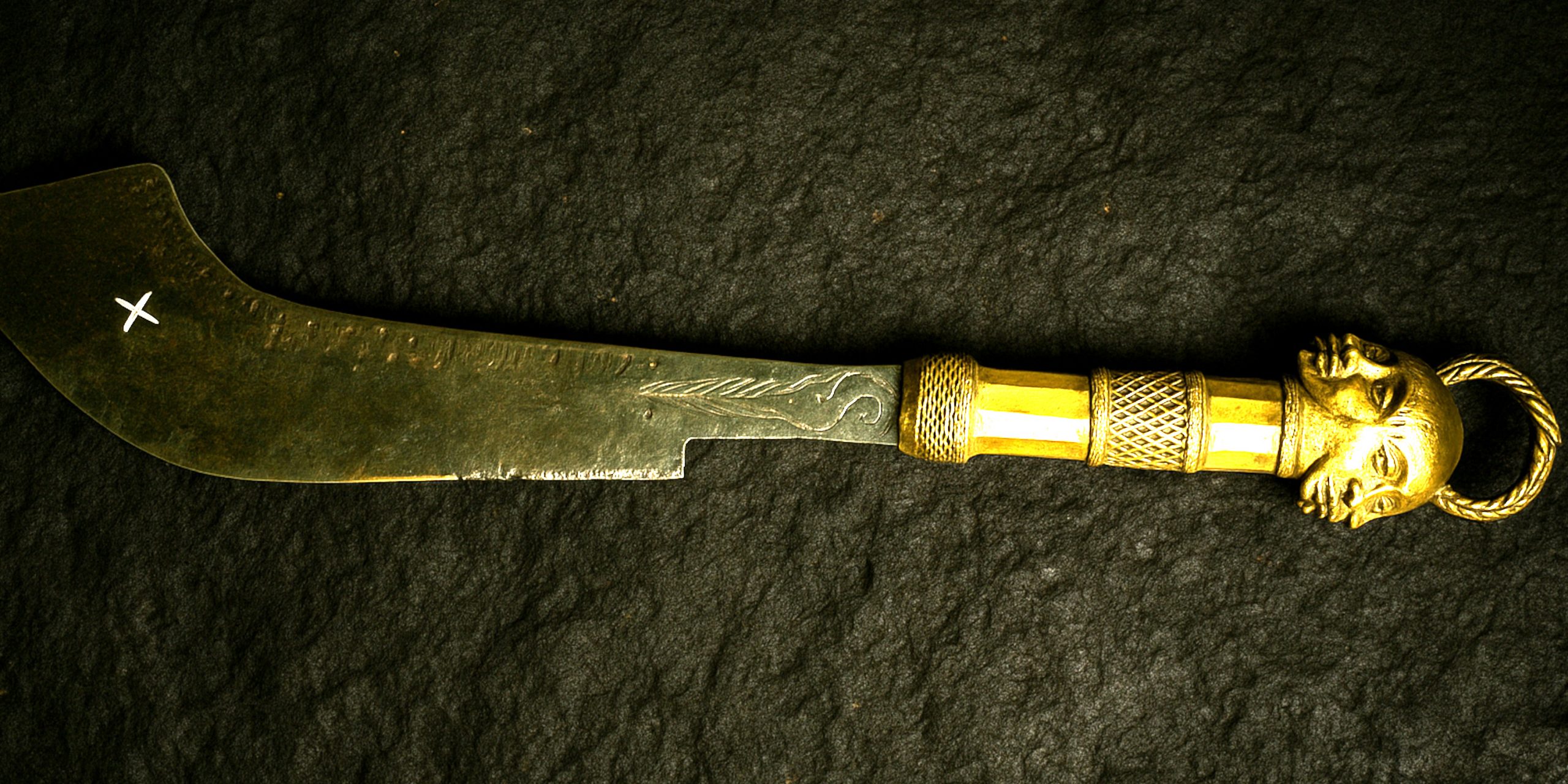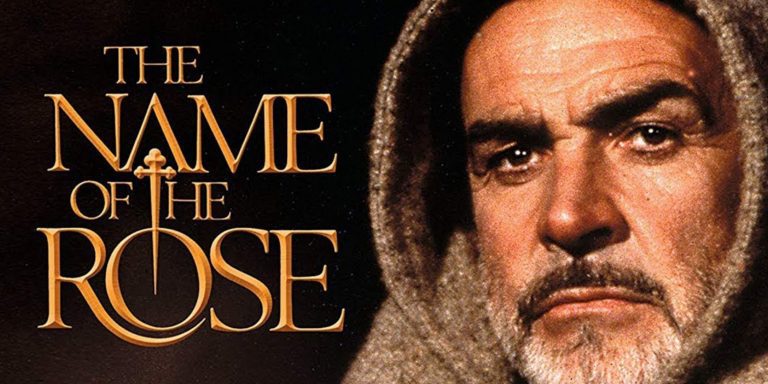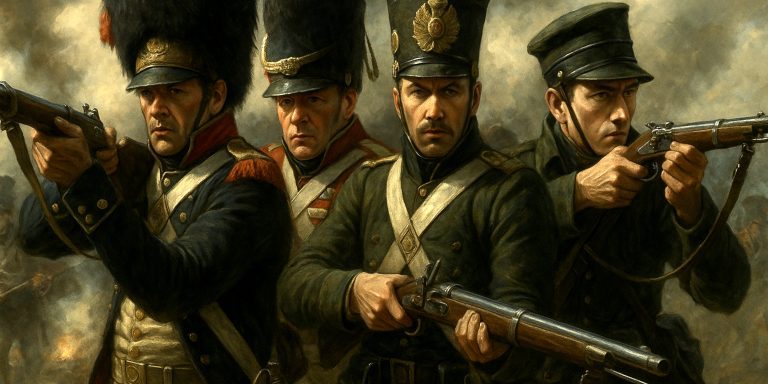
The Yoruba Ogboni sword sits in an unusual place within West African material culture. It is not a battlefield weapon in the traditional sense but an instrument of status, ritual, and encoded symbolism. The Ogboni society, also known as the Osugbo in some regions, acted as a council of elders that balanced secular authority with spiritual oversight. Their regalia reflected this dual role. The sword, often short and thick with a sculptural, cast brass or copper alloy form, signalled rank and carried metaphysical meaning tied to justice, secrecy, and the earth itself.
Although compact and sometimes abstract in profile, these blades show remarkable craftsmanship. They can feature stylised figures, exaggerated pommels, geometric patterning, and complex iconography that hint at the elite class who commissioned them. For collectors, they sit at the intersection of ethnographic art and ceremonial weaponry, offering an intriguing blend of symbolism and metallurgy.
Specification
A typical Yoruba Ogboni sword adheres to the following characteristics:
General Characteristics
- Function: Ritual or ceremonial use within Ogboni and Osugbo lodges
- Region: Yoruba areas of Nigeria
- Material: Predominantly cast brass or copper alloy, sometimes iron cores with brass cladding
- Length: Usually 25 to 45 centimetres
- Blade Type: Thick, flat, non edged or minimally edged, often with decorative surface treatment
- Hilt: Stylised, sometimes anthropomorphic, often cast in one piece with the blade
- Scabbard: Rare, since many pieces were not stored as functional weapons
Specification Table
| Feature | Typical Form |
|---|---|
| Overall Length | 25 to 45 cm |
| Weight | 300 to 900 g depending on casting thickness |
| Blade Material | Brass, bronze, copper alloy, or mixed metallurgy |
| Hilt Design | Integrated cast hilt, geometric or figurative |
| Edge | Non functional or lightly bevelled |
| Purpose | Ritual authority, insignia of rank |
History and Evolution
The Ogboni society dates back centuries within Yoruba political and spiritual life. It held responsibility for conflict resolution, upholding moral order, and maintaining traditions linked to the earth deity Onile. Its regalia developed in parallel with these duties. The sword, rather than a tool of violence, served as a physical embodiment of truth, judgement, and communal stability.
Early examples likely evolved from iron bladed ceremonial knives, but brass and bronze casting, already flourishing among Yoruba and Benin craftsmen, gave later pieces their distinctive sculptural character. During the nineteenth century, as colonial encroachment altered political structures, Ogboni symbols took on greater significance. The sword became a portable anchor for identity and continuity at a time of upheaval.
By the twentieth century, many pieces were created both for ceremonial use and for the growing market of art collectors interested in West African metallurgy. Although modern examples exist, high quality traditional swords remain valued for their craftsmanship and cultural resonance.
Advantages and Disadvantages
Advantages
- Highly durable due to solid casting
- Deep symbolic and cultural significance
- Distinctive aesthetic appeal for collectors of African art
- Rare examples with figurative motifs demonstrate exceptional skill
Disadvantages
- Not suitable as functional weapons
- Iconography requires careful interpretation to avoid misattribution
- Variable quality in twentieth century tourist pieces
- Provenance can be difficult to verify without specialist knowledge
Comparison with Similar Weapons
Although functionally different from combat blades, several African ritual or prestige weapons invite comparison.
| Weapon Type | Region | Similarities | Differences |
|---|---|---|---|
| Benin Court Swords | Edo Kingdom | Cast brass, ceremonial purpose, symbolic motifs | Often more elaborate with plaques and royal associations |
| Kuba Ikul Prestige Knives | DR Congo | Used as insignia, stylised forms | Usually forged iron rather than cast metal |
| Akan Ceremonial Blades | Ghana | Ritual context and inherited symbolism | More varied in blade shape and often ornamented with gold leaf |
| Dahomey Ceremonial Knives | Benin Republic | Linked to court hierarchy | More likely to have sharp iron edges |
The Ogboni sword remains distinct due to its integrated casting, compressed proportions, and close association with the earth cults and elder councils of Yoruba society.
Legacy
Ogboni swords have shifted from guarded regalia to prized artefacts of African cultural history. They appear in museums worldwide, usually within collections of ethnographic metalwork or Yoruba ritual arts. Their legacy lies less in martial history and more in their narrative power. They act as anchors for Yoruba identity, reminders of indigenous governance structures, and windows into sophisticated casting techniques long established in West Africa.
Modern Yoruba communities still retain Ogboni lodges, though symbols are used more sparingly. Contemporary artists also draw stylistic inspiration from Ogboni regalia, reimagining traditional forms in sculpture, jewellery, and mixed media.
Where to See
- British Museum, London
Contains Yoruba brass objects and ritual regalia, including Ogboni paraphernalia. - National Museum, Lagos
Offers one of the most comprehensive collections of Yoruba ceremonial artefacts. - Metropolitan Museum of Art, New York
Displays African metalwork, including several cast brass ceremonial blades. - Musée du Quai Branly, Paris
Strong holdings of West African ritual objects and prestige weapons.
Collector’s Guide
What Collectors Look For
- Provenance from respected estates or long held collections
- High quality early casting with crisp detail
- Integrated hilt and blade from a single mould
- Presence of figurative motifs or symbolic markings
- Patina consistent with age, free of over polishing
Market and Auction Prices
- Mid range ritual swords of simple geometric form: 200 to 500 GBP
- Well detailed cast examples with figurative hilts: 500 to 1,200 GBP
- Rare, early, or museum quality pieces: 1,500 to 4,000 GBP or higher depending on craftsmanship and provenance
- Tourist or late twentieth century pieces: 50 to 150 GBP
Buying Tips
- Compare weight and casting texture against verified museum examples
- Seek documentation where possible
- Avoid repatinated surfaces that mask imperfections
- Consult specialists familiar with Yoruba material culture
The Seven Swords Takeaway
The Yoruba Ritual Ogboni sword stands as a powerful symbol of authority, moral order, and ancestral continuity rather than a battlefield implement. Its compact form and sculptural quality offer a fascinating study in West African craftsmanship, making it a strong area of interest for collectors, historians, and anyone drawn to the interplay of ritual and artistry.



